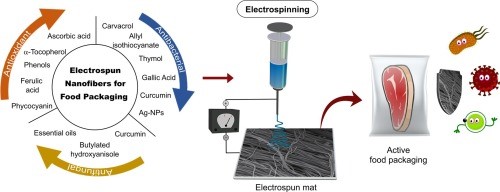
What is Cell Electrospinning in Microencapsulation?
Traditional food packaging is primarily developed to provide mechanical support and to isolate foods from external influences, such as microorganisms, moisture, oxygen, odors, dusts, and mechanical forces. However, contamination could occur throughout the whole food industry chain including harvesting, postprocessing, distribution, transportation, storage, and retail display stages. A good packaging system was thus required for ensuring convenience in food handling, maintaining the food quality, extending the shelf life, and preventing the foods from deterioration and spoilage. Then, active food packaging was designed to release preserving agents or scavenge undesirable substances, beyond the use as a simple barrier between the external environment and packaged foods. Microbial contamination has been considered as an important factor inducing food spoilage.

Source: ScienceDirect.com
Nowadays, numerous techniques including solvent casting, extrusion, thermoforming, and compression molding have been employed to prepare thin films from polymer matrices for packaging. Compared with these techniques, electrospinning is an emerging and powerful technique used to fabricate continuous polymer fibers with different morphologies and structures, which are deposited on the collector to form a fibrous film. Due to the nano-sized dimensions, the size effect of electrospun fibers contributes to a very high surface activity, which is desirable for active food packaging. Moreover, the different electrospinning designs can be used to modify the morphology and structure of electrospun fibers, which are expected to achieve the protection of various active agents and the improved mechanical and barrier properties in the active packaging systems.
References:
https://onlinelibrary.wiley.com/doi/full/10.1111/1541-4337.12536





